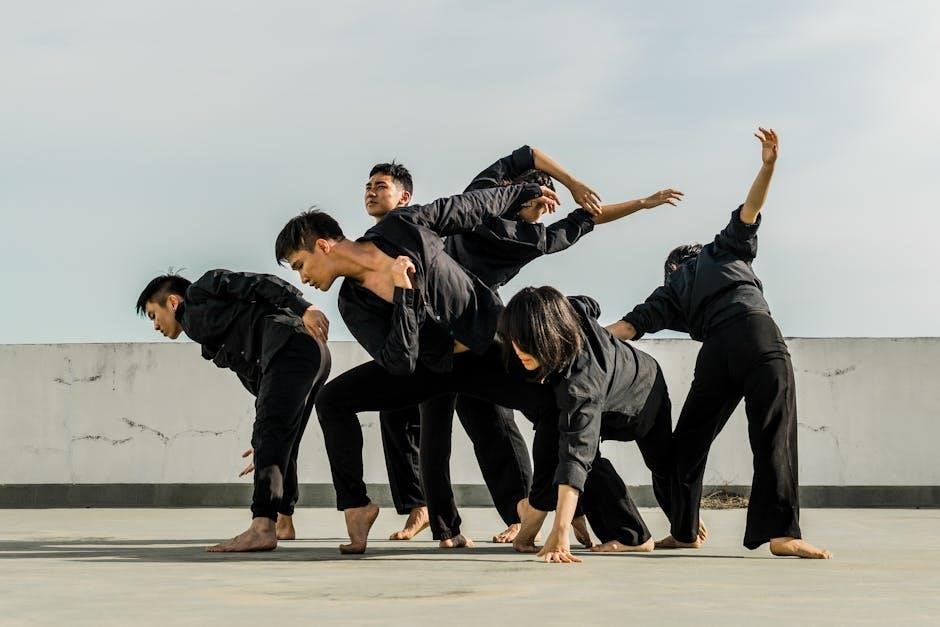coordination exercises for ataxia pdf
Ataxia is a neurological disorder affecting coordination and balance, caused by cerebellum or its connection issues. It impairs motor skills, causing difficulty in voluntary movements, balance, and daily activities.
1.1 Understanding Ataxia: Definition and Types
Ataxia is a neurological disorder characterized by impaired coordination and balance, often caused by cerebellum or nervous system damage. It manifests in various types, including cerebellar, sensory, and vestibular ataxia, each affecting motor skills differently. Symptoms include gait disturbances, tremors, and difficulty with voluntary movements, significantly impacting daily activities and requiring tailored therapeutic approaches.
1.2 The Role of Coordination in Managing Ataxia
Coordination plays a vital role in managing ataxia by enhancing balance and motor function. Through targeted exercises, individuals can improve their ability to perform daily tasks, reducing the risk of falls and injuries. Regular practice strengthens neural pathways, promoting better control over voluntary movements and overall physical stability, essential for maintaining independence and quality of life.

The Importance of Coordination Exercises for Ataxia
Coordination exercises are crucial for managing ataxia, as they improve balance, stability, and motor function, enhancing overall mobility and reducing the risk of falls and injuries.
2.1 How Coordination Exercises Improve Balance and Stability
Coordination exercises enhance balance and stability by strengthening motor control and proprioception. These exercises, such as Frenkel exercises and vestibular training, improve static and dynamic balance, reducing the risk of falls. By targeting specific muscle groups and promoting neural adaptation, they help individuals with ataxia achieve better postural alignment and overall physical stability, enhancing daily activities and independence.
2.2 The Science Behind Motor Function Improvement in Ataxia
Motor function improvement in ataxia stems from neuroplasticity, where exercises like coordination training stimulate cerebellar recovery. Enhanced neural pathways and muscle memory from repetitive exercises promote better movement control. Studies show that structured programs, including Frenkel exercises and agility drills, significantly reduce symptoms by strengthening brain-muscle communication, leading to improved coordination and balance over time with consistent practice.

Key Components of Coordination Exercises for Ataxia
Effective coordination exercises for ataxia include static and dynamic balance training, Frenkel exercises, agility drills, and sensory integration techniques to enhance motor control and overall stability.
3.1 Balance Training: Static and Dynamic Balance Control
Balance training is crucial for managing ataxia, focusing on both static and dynamic control. Static balance involves maintaining stability in stationary positions, while dynamic balance requires coordination during movement. Exercises like single-leg stands, heel-to-toe walking, and wobble board training enhance stability and reduce the risk of falls, improving overall motor function and daily activity performance.
3.2 Frenkel Exercises: A Proven Method for Ataxia
Frenkel exercises are a systematic approach designed to improve coordination and reduce ataxia symptoms. These exercises emphasize repetition, precision, and concentration, targeting voluntary movements. They progress from simple to complex tasks, enhancing motor control and balance. Regular practice has shown significant improvement in ataxic patients, making them a cornerstone in rehabilitation programs.
3.3 Agility Drills: Lateral Plyometric Jumps and High Knee Drills
Agility drills like lateral plyometric jumps and high knee drills enhance coordination and balance in ataxia patients. These exercises involve rapid, precise movements, improving reaction time and motor control. Lateral plyometric jumps focus on explosive power and stability, while high knee drills target rhythm and coordination. Both are essential for advancing motor skills and reducing ataxia symptoms effectively.
Vestibular and Eye-Head Coordination Exercises
Vestibular and eye-head coordination exercises target balance and spatial orientation, crucial for managing ataxia. These drills involve repetitive, progressively challenging movements to enhance stability and reduce dizziness.
4.1 The Role of Vestibular Training in Ataxia Management
Vestibular training plays a crucial role in managing ataxia by enhancing balance, spatial orientation, and gaze stability. It involves repetitive exercises like eye-head movements and body tilts to improve sensory integration. This therapy targets the vestibular system, reducing dizziness and postural instability, which are common in ataxia patients. Regular practice can significantly enhance overall motor function and independence.
4.2 Eye-Head Movement Exercises for Enhanced Coordination
Eye-head movement exercises are designed to improve coordination by synchronizing visual and vestibular systems. These exercises involve tracking objects, focusing on stationary points, and performing head movements. They help reduce dizziness, enhance spatial awareness, and improve balance. Regular practice strengthens neural pathways, leading to better motor control and reduced ataxia symptoms in daily activities and mobility.

Home-Based Exercise Programs for Ataxia
Home-based exercise programs offer flexibility and convenience for managing ataxia. They include balance, coordination, and strength exercises tailored to individual needs, improving motor function effectively.
5.1 A Home Balance Exercise Program: Structure and Benefits
A home balance program for ataxia focuses on static and dynamic exercises, like single-leg stands and heel-to-toe walks, improving stability. Regular practice enhances coordination, reduces fall risks, and boosts confidence, making daily activities easier. These exercises are structured to be safe, gradual, and adaptable to individual progress, ensuring consistent improvement in motor function and independence.
5.2 Video Game-Based Coordinative Training for Children
Video game-based training engages children with ataxia through interactive activities, enhancing coordination and balance. Games incorporating movement challenges, such as virtual obstacle courses, promote motor function improvement. This method is effective, as it maintains engagement and motivation, making therapy enjoyable while fostering progress in coordinative skills and overall motor development in a fun, immersive environment.
Creating a PDF Guide for Coordination Exercises
A PDF guide for coordination exercises offers structured routines, visual aids, and progress tracking. It simplifies ataxia management, providing accessible tools for effective rehabilitation and home practice.
6.1 Structuring the PDF: Essential Sections and Visual Aids
A well-structured PDF guide should include an introduction, exercise routines, and visual aids. Essential sections may cover balance training, Frenkel exercises, and agility drills. Incorporating images, diagrams, and progress tracking sheets enhances clarity and user engagement, making the guide comprehensive and accessible for individuals with ataxia and their caregivers.
6.2 Including Progress Tracking and Safety Guidelines
Include a progress tracking section with exercise logs and achievement markers; Add safety guidelines to prevent injuries, such as starting slowly and consulting a therapist. Provide tips for modifying exercises based on individual needs and emphasizing proper form. This ensures a safe and effective workout routine for ataxia management, promoting consistent improvement and user confidence.
Success Stories and Case Studies
Studies highlight significant improvements in motor function and balance through coordination exercises. Patients reported reduced ataxia symptoms and enhanced daily activity performance, showcasing the effectiveness of targeted therapies and personalized routines.
7.1 Improvements in Motor Function Through Coordination Training
Coordination training has shown significant benefits for individuals with ataxia, enhancing motor function and reducing symptoms. Studies reveal improved balance, gait, and voluntary movement control. Frenkel exercises and vestibular training are particularly effective, promoting neural adaptation and functional recovery. These advancements enable better performance of daily activities, highlighting the critical role of targeted exercises in managing ataxia.
7.2 Patient Testimonials and Real-Life Examples
Patient testimonials highlight the transformative impact of coordination exercises on ataxia management. Many report improved balance, gait, and daily functioning. One individual shared, “After consistent Frenkel exercises, I regained confidence in walking without assistance.” Real-life examples demonstrate how tailored programs, including vestibular training, have empowered patients to achieve meaningful progress in motor control and independence, enhancing their quality of life significantly.
Challenges and Adaptations in Ataxia Rehabilitation
Ataxia rehabilitation faces challenges like balance deficits and coordination issues. Adaptations include tailored exercises, progressive difficulty, and sensory integration techniques to address individual needs effectively.
8.1 Overcoming Balance and Coordination Deficits
Addressing balance and coordination deficits in ataxia requires tailored approaches. Techniques like balance training, Frenkel exercises, and vestibular therapy help improve stability and motor control. Gradual progression and sensory integration strategies are essential. These methods enhance overall mobility and reduce the risk of falls, promoting independence and quality of life for individuals with ataxia.
8.2 Customizing Exercises for Individual Needs
Personalized exercise plans are crucial for ataxia management, ensuring each patient’s unique challenges are addressed. Physical therapists assess motor deficits and tailor routines, incorporating elements like Frenkel exercises, agility drills, and balance training. Adaptations include modifying intensity, duration, and complexity to suit individual capabilities, fostering progressive improvement and maximizing therapeutic outcomes effectively for diverse patient needs and conditions.
The Role of Physical Therapy in Ataxia Management
Physical therapy plays a vital role in managing ataxia by improving coordination, balance, and motor function through structured exercises and techniques like Frenkel exercises, tailored to individual needs.
9.1 Physical Therapy Approaches for Coordination and Balance
Physical therapy incorporates personalized exercise plans to enhance coordination and balance in ataxia patients. Techniques include Frenkel exercises, vestibular training, and progressive balance drills. These methods focus on improving motor function, reducing instability, and promoting independence. Professional guidance ensures exercises are adapted to individual needs, maximizing therapeutic outcomes and overall quality of life for those with ataxia.
9.2 The Importance of Professional Guidance
Professional guidance is crucial for designing personalized exercise plans tailored to individual ataxia symptoms. Physical therapists provide expert oversight, ensuring exercises are performed safely and effectively. Their expertise helps maximize benefits, prevent injuries, and adapt routines as progress occurs, making them indispensable for achieving optimal motor function and independence in ataxia management.

Future Directions in Ataxia Exercise Development
Future directions include emerging trends like personalized exercise plans and technology integration, enhancing therapy outcomes through virtual reality and wearable devices for improved ataxia management.
10.1 Emerging Trends in Rehabilitation Techniques
Emerging trends in ataxia rehabilitation include personalized exercise programs, virtual reality therapy, and wearable technology. These innovations aim to enhance motor learning and adaptability, providing tailored interventions for improved coordination and balance. Such approaches are increasingly used alongside traditional methods like Frenkel exercises to optimize outcomes and patient engagement in ataxia management.
10.2 Technology Integration for Enhanced Therapy Outcomes
Technology, such as virtual reality and wearable devices, is revolutionizing ataxia rehabilitation by providing immersive, real-time feedback. Video game-based therapies engage patients, especially children, while sensors track progress. These tools enhance traditional exercises like Frenkel drills, offering personalized and interactive approaches to improve coordination, balance, and motor function effectively.
11.1 Summary of Key Findings
Coordination exercises significantly improve motor function in ataxia patients by enhancing balance, stability, and voluntary movement control. Studies highlight the effectiveness of Frenkel exercises, balance training, and vestibular exercises in reducing symptoms. Video game-based training shows promise, especially for children. Long-term rehabilitation programs demonstrate measurable progress, emphasizing the importance of consistent practice and professional guidance for optimal outcomes.
11.2 Final Thoughts on Effective Ataxia Management
Effective ataxia management requires a combination of coordination exercises, balance training, and vestibular therapy. Frenkel exercises, agility drills, and video game-based programs offer promising results; Professional guidance ensures safety and adaptability, while consistent practice enhances motor function. Integrating technology and personalized plans can further optimize outcomes, providing hope for improved quality of life and independence for individuals with ataxia.